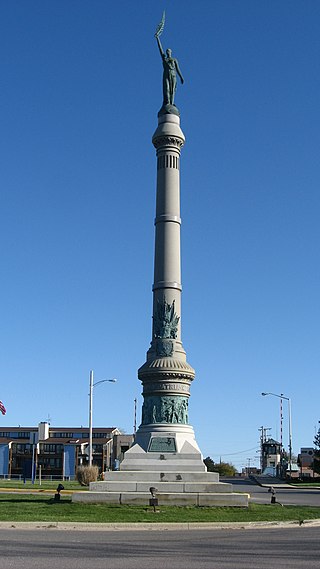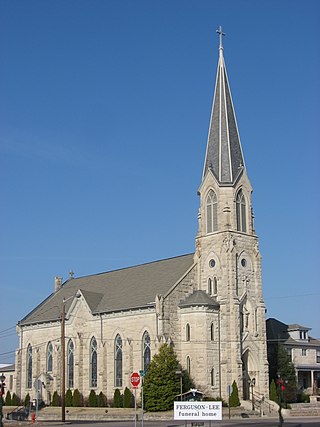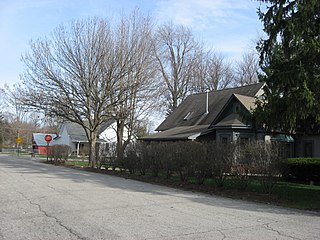
Forest Hills Historic District is a national historic district located at Indianapolis, Indiana. It encompasses 173 contributing buildings and 7 contributing structures in a planned residential section of Indianapolis. It developed between about 1911 and 1935, and includes representative examples of Tudor Revival and English Cottage style architecture.
Jackson–Washington State Forest is a state forest in Jackson and Washington Counties, Indiana, near the town of Brownstown. The forest includes over 18,000 acres (7,300 ha), most of which was bought by the state in the 1930s and 1950s. Jackson–Washington State Forest offers camping, fishing, hunting, archery, and trails for hiking, horseback riding, and cycling.

Pipe Creek Falls Resort is a national historic district located at Tipton Township, Cass County, Indiana. The district encompasses five contributing buildings, one contributing site, and two contributing structures associated with a recreational site and campground on a wooded site overlooking Pipe Creek. It developed between about 1888 and 1940 and includes notable examples of Bungalow / American Craftsman style architecture. Notable contributing resources include the Pipe Creek Grist Mill (1914), generator shed (1914), bath house (1914), storage shed (1940), restroom (1940), concession stand (1940), the foundation of a carousel, and rock shelters.

Washington Park is a historic public park and national historic district located on Lake Michigan at Michigan City, LaPorte County, Indiana. The park encompasses 13 contributing buildings, 3 contributing sites, 11 contributing structures, and 21 contributing objects, and includes the Michigan City Zoo. It was established in 1891 and later developed by the Works Progress Administration and its predecessors during the 1930s. Notable features include the Soldiers' and Sailors' Monument (1896), former park headquarters building (1934), bandstand (1911), World War I doughboy monument (1926), tennis court, log picnic shelter, and four-story observation tower (1936).

Bedford Courthouse Square Historic District is a national historic district located at Bedford, Lawrence County, Indiana. The district encompasses 64 contributing buildings, 1 contributing site, and 1 contributing object in the central business district of Bedford. It developed between about 1850 and 1945, and includes examples of Italianate, Romanesque Revival, and Neoclassical style architecture. Notable contributing resources include the Soldiers', Sailors' and Pioneers Monument (1923); Michael A. Malott House ; Moses Fell Building ; Stone City Bank Building ; Dunn Memorial Masonic Temple (1918); Lawrence County Courthouse (1930); Bedford Fire Department Building ; Citizens' Bank Building (1926); Elks Club (1916); Hamer Building ; and Bedford Municipal Garage (1937).

Zahn Historic District is a national historic district located at Bedford, Lawrence County, Indiana. The district encompasses 66 contributing buildings, 1 contributing structure, and 1 contributing object in a predominantly residential section of Bedford. It developed between about 1847 and 1947, and includes examples of Late Gothic Revival, Second Empire, and Queen Anne style architecture. Notable buildings include the St. Vincent DePaul Church (1893), Gaussin House (1875), John Zahn House, George Gratzer House, Asa Bridwell House, and Horace Casada House.

Ninth Street Hill Neighborhood Historic District is a national historic district located at Lafayette, Tippecanoe County, Indiana. The district encompasses 88 contributing buildings and 6 contributing structures in a predominantly residential section of Lafayette. It developed between about 1850 and 1946 and includes representative examples of Gothic Revival, Italianate, Queen Anne, Greek Revival, and Second Empire style architecture. Located in the district is the separately listed Judge Cyrus Ball House. Other notable contributing resources include the Samuel Moore House (1891), Moore-Porter-Boswell House (1895), Stanley Coulter House (1890), Edward Bohrer House (1909), Thomas Wood House, Job M. Nash House (1859), and Gordon Graham House.

Dayton Historic District is a national historic district located at Dayton, Indiana, Tippecanoe County, Indiana. The district encompasses 82 contributing buildings and 1 contributing site in the central business district and surrounding residential sections of Dayton. It developed between about 1830 and 1952 and includes representative examples of Greek Revival, Italianate, Second Empire, and Bungalow / American Craftsman style architecture. Notable contributing resources include the Lantz Building (1941), Reincke-Hawkins House, Castle Block (1894), Baker-Yost House, First Presbyterian Church (1899), and Gladden-Goldsbury House.

Forest Hills Country Club is a historic country club located in Wayne Township, Wayne County, Indiana. The clubhouse was built in 1927, and is a two-story, stuccoed, Tudor Revival style building. It has a cross-gable roof with half-timbering on the gable ends. William H. (Bill) Diddel designed a nine-hole golf course for the Forest Hills Country Club in 1927. In 1931, the club brought Diddel back to add another nine holes. Also on the property are the contributing swimming pool, two maintenance buildings, and two shelters.

Hillcrest Country Club, also known as Avalon Country Club, is a historic country club located in suburban Lawrence Township, Marion County, Indiana, northeast of Indianapolis, Indiana. The 18 hole golf course was designed by Bill Diddel and was built in 1924. The clubhouse was built in 1929–1930, and renovated in 2000. It is a three-story, Mission Revival style with tall arched openings, and a low tile roof with bracketed eaves. Also on the property are the contributing swimming pool (1934), well house, and water pump.

Brendonwood Historic District, also known as Brendonwood Common, is a national historic district located at Indianapolis, Indiana. It encompasses 85 contributing buildings, 2 contributing sites, and 1 contributing object in a planned suburban residential section of Indianapolis. 350 acres on the eastern edge of Millersville with Fall Creek as the western boundary was the vision of Charles S. Lewis for a self-regulated residential zone of 110 plots. Noted landscape architect George E. Kessler was hired to develop the planned community. The district developed between about 1917 and 1954, and includes representative examples of Tudor Revival, Colonial Revival, and Bungalow / American Craftsman style architecture. Notable contributing resources include the Common House (1924), golf course, Two Knolls (1951-1952), Farlook (1939), Springhead (1934), Dearwald (1927), Wancroft (1940), Larkwing (1952), Grasmere (1937-1938), Wetermain (1921), Whispering Trees (1952-1953), Glen Gate (1922-1923), Witching View (1928-1929), Long Ridge (1923-1924) and Great Maple (1948).

New Augusta Historic District is a national historic district located at Indianapolis, Indiana. It encompasses 114 contributing buildings, 1 contributing structure, and 1 contributing object in a railroad oriented village in Indianapolis. The district developed between about 1852 and 1939, and includes representative examples of Italianate and Bungalow / American Craftsman style architecture. Notable contributing buildings include the Odd Fellows Building, Hopewell Evangelical Lutheran Church, Salem Lutheran Church (1880), and New Augusta Depot. It is located west of Augusta.

Cumberland Historic District is a national historic district located at Cumberland, Indiana. It encompasses 91 contributing buildings in the Cumberland section of Indianapolis. The district developed between about 1831 and 1950, and includes representative examples of Folk Victorian and Bungalow / American Craftsman style architecture. Notable contributing resources include the Cumberland Bank (1907), Masonic Lodge, Miller's Lunch, and First Baptist Church (1912-1913).

North Meridian Street Historic District is a national historic district located at Indianapolis, Indiana. It encompasses 169 contributing buildings in a high style residential section of Indianapolis. The district developed between about 1900 and 1936, and includes representative examples of Tudor Revival, Colonial Revival, and Classical Revival style architecture. Located in the district is the separately listed William N. Thompson House. Other notable contributing resources include the Evan-Blankenbaker House (1901), Sears-Townsend House (1930), MacGill-Wemmer House, Hugh Love House (1930), Hare-Tarkington House (1911), Shea House (1922), and Brant-Weinhardt House (1932).

Irvington Terrace Historic District is a national historic district located at Indianapolis, Indiana. It encompasses 578 contributing buildings and 9 contributing sites in a planned residential section of Indianapolis. The district developed between about 1895 and 1959, and includes representative examples of Tudor Revival, Colonial Revival, and Bungalow / American Craftsman style residential architecture.

Camp Edwin F. Glenn is a national historic district located at Fort Benjamin Harrison, Indianapolis, Indiana. It encompasses 19 contributing buildings and 360 contributing structures in a former military camp. The district developed between about 1925 and 1941. It originally served as a Citizens' Military Training Camp from 1925 to 1941, a camp for the Civilian Conservation Corps from 1933 to 1941, and a Prisoner of War camp from 1944 to 1945. The district includes six warehouses, five mess halls, five lavatories, a branch exchange, butcher shop, latrine, and 360 concrete tent pads.

St. Philip Neri Parish Historic District is a historic Roman Catholic church complex and national historic district located at Indianapolis, Indiana. The district encompasses five contributing buildings: the church, rectory, former convent and school, school, and boiler house / garage. The church was built in 1909, and is a Romanesque Revival brick church with limestone trim. It features two- and three-story crenellated corner towers, a rose window with flanking round arched windows, and Doric order columns flanking the main entrance.

Watson Park Historic District, also known as Watson Road Historic District and Watson McCord Neighborhood, is a national historic district located at Indianapolis, Indiana. The district encompasses 402 contributing buildings and 4 contributing sites in a predominantly residential section of Indianapolis. They include 255 houses, 27 multiple family dwellings, and 120 garages. It was developed between about 1910 and 1960, and includes representative examples of Colonial Revival, Tudor Revival, and Bungalow / American Craftsman style architecture. Located in the district is the Watson Park Bird Sanctuary.

Woodstock Country Club is a historic country club and national historic district located at Indianapolis, Indiana. It was developed between 1923 and 1956 and includes the 1923 Colonial Revival clubhouse expanded in 1957 and 1988. It consists of a central block with flanking wings and a three-arch porte cochere. Also on the property are the contributing main swimming pool and upper and lower tennis courts. The golf course was originally designed in 1899 and reconstructed in 1927-1928 by Bill Diddel.

Ulen Historic District, also known as Country Club Addition, is a national historic district located at Ulen, Boone County, Indiana. The district encompasses 53 contributing buildings, 2 contributing sites, 1 contributing structure, and 4 contributing objects in an upscale suburban area near Indianapolis and next to the Ulen Country Club and golf course. The golf course was the first designed by Bill Diddel. The district developed between about 1924 and 1963, and includes representative examples of Colonial Revival, Tudor Revival, Mediterranean Revival, and Ranch Style architecture.
























